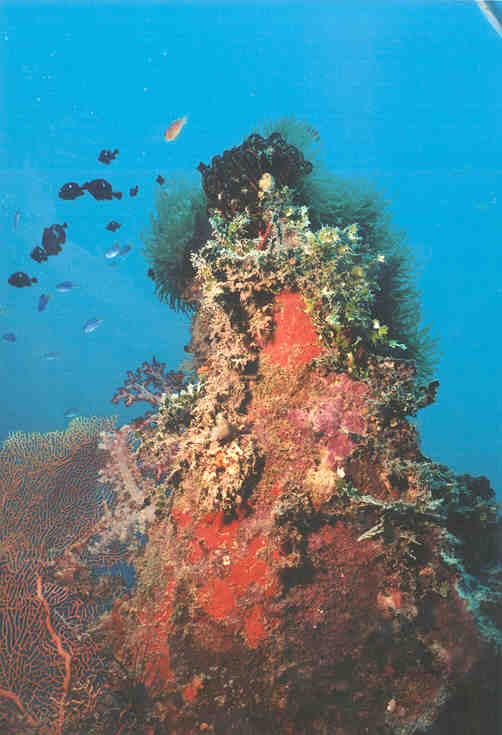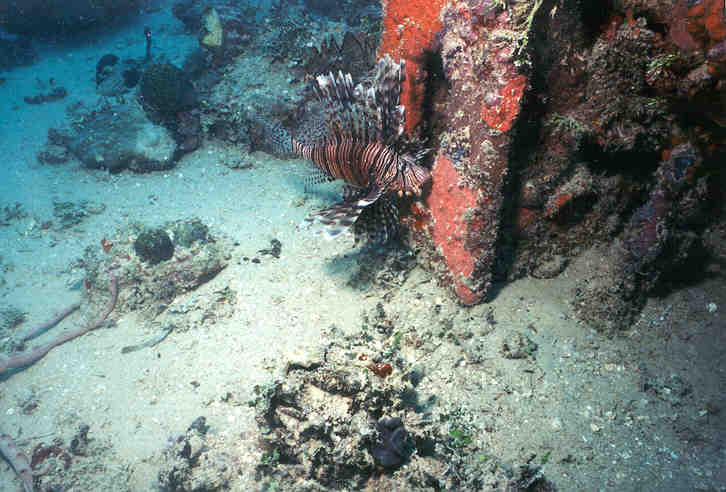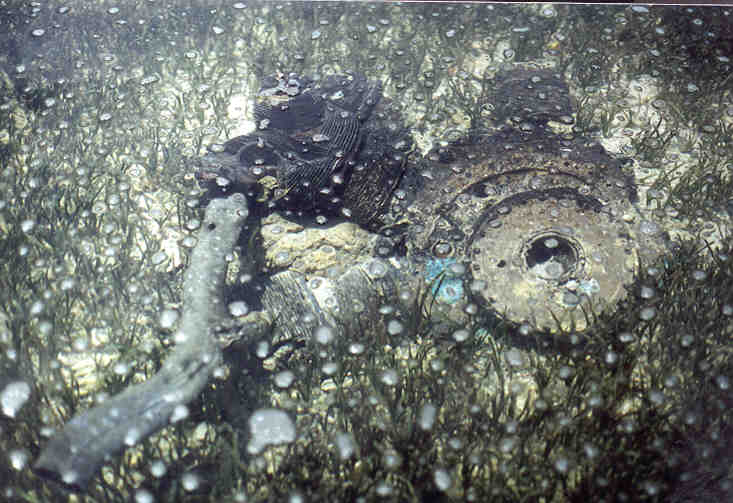
Typical underwater scene on the wreck of the Hanikawa Maru
Click here to go to the South Pacific page. Click here to go to the sabbatical 2002 webpage.
Truk is in many ways the highlight of my vacation. I go to Truk to dive the shipwrecks from World War Two. There really isn't much else to do at Truk, but the diving is so good that it's still a great time.

Typical underwater scene on the wreck of the Hanikawa Maru
You might have heard of Truk, although you probably have not. If you search for Truk on a map you might never find it. The name has changed to "Chuuk", which is pronounced "Chook". Why they spell Chuuk with two "U"s, instead of two "O"s is anybody's guess. At any rate, Truk is about halfway between Hawaii and the center of Australia.
Since both Hawaii and Australia played major roles in World War II, it's not a big surprise that Truk was a focal point in the war, as well. The Japanese Combined Fleet was headquartered here, in one of the world's best harbors, Truk Lagoon. From Truk, all manner of war material could be distributed throughout the Empire. Aircraft, ammunition, fuel and troops were staged through Truk, and Japanese ships returning to the home islands called on Truk on their way home. Truk was one of Japan's most important forward bases.
One day, all that changed. Truk was flattened by a US naval Task Force and dozens of ships were sunk, complete with their cargos of aircraft and etcetera. That's part of what makes diving in Truk Lagoon so great, the wrecks are intact. Shipwrecks in other parts of the world have been salvaged, for example, but Truk was so far away that salvage wasn't economically feasible.
I touched down at the airport and manhandled my dive gear through customs. I was met by one of the Blue Lagoon Dive Shop's desk-jockies, Reggie. Reggie is an unusual Chuukese. He has asian features, which isn't all that uncommon, and he's humorless, which is very uncommon. Reggie got me pointed toward the dive shop's van, where I stowed my gear. Soon thereafter, I was joined by a couple of Japanese tourists and we headed south to the hotel.
I was fairly burned out by this time. My "day" had actually started the day before on Bali. I had flown overnight to Guam where I met my friend Dave, who handed me my gear bag with all my technical dive gear. From Guam I flew to Truk and unloaded. However, even though I was a little tired, I was ready to dive. I hustled Reggie to see if I could get on an afternoon boat. He said to come to the shop at 2:00 and see. I went to my room, took a shower, and crashed.
I got up at 2:00 and went to the dock. The news was: No afternoon boat. So, I decided to go "downtown" and pick up supplies. The hotel where I stayed this time is a little remote so it's a minor expedition to pick up groceries and, more importantly, beer.
The conventional method for going to town is to have the hotel desk hail a cab. I find this technique lacking in creativity. Most vehicles in Truk are for hire, so it's not hard to find a "cab". Many drivers will pick you up anyway, so you can meet some colorful characters by walking in the direction you want to go. Somebody will give you a lift. I didn't get more than a few hundred yards before a Toyota Forerunner stopped and the driver asked if I wanted a ride. I piled in and met two Trukese, Hart and Harty. Harty is an off-duty police officer and Hart is a desk-jockey at the dive shop. The last time I was here, I dove with Hart's brother, Renty. I told Hart that I had been hoping to dive with Renty again. Renty is as good a divemaster as I've ever seen anywhere in the world.
Eventually, I was back at my hotel room with a cold beer in my fist. Outside my room, I spoke briefly with one of the staff. Her name is Tio. Tio is Renty's mom. She told me that the big typhoon that blew through Truk a few weeks back killed thirteen people from her village. I had read that almost fifty people had died, but this was the first time that I knew that anybody from Renty's village, and therefore his clan, had gotten caught in the mudslide. What a bummer!
The next day I went diving with the Japanese tourists that came in on my flight with me. They seemed friendly enough, but we had no common language and couldn't communicate very well. We did easy dives. First, the Kansho Maru, then a surface interval on Jeep Island and a dive on the Rio de Janeiro Maru. We were diving with the dive shop's manager, Chenny. As we unloaded back at the shop, Chenny asked me if I was a deep diver and I answered in the affirmative.
So it came to pass that I got hooked up with a couple of other deep divers, Malcom and Pete. These guys are from merry old England and they run the website Truk-Lagoon.com. They're fine lads, really, and we had some great dives together. They're also photographers and videographers. I'm hoping that they post some photos to their site so I can see what kind of photos they got from this trip.
The days went by and the diving was great. It had been windy, which made the boat rides out to the dive sites a little rough. However, the wind died down and the lagoon got flat enough to water ski on. Conditions were improving, because now we could take long boat rides out to dive sites like the Hanakawa Maru, out in the west end of the lagoon.

A Poisonous Lionfish Hunting on the Hanikawa's After Deck.
We were diving two wrecks every day. We spent our surface intervals on Jeep Island, which is a little island with minimal facilities that's overcrowded with Japanese tourists. I saw more Japanese this time around than I've ever seen at Truk before. The Japanese were mostly fishermen, but there were quite a few who seemed to be spending their vacation crammed elbow-to-elbow on Jeep Island. Finally, we asked Renty if we could spend our surface intervals ashore at the hotel. He didn't have a problem with that, so we started washing the salt off in our showers and laying around our hotel rooms for the three hours we stayed topside every day.
After a while, my buddies from Guam showed up. Dave and Sue are more or less locals here at Truk. Sue is a flight attendant on Continental Air Micronesia and her plane sets down in Truk on every flight. She and Dave have been diving here since the 1970s. They're great to have along. Sue unpacked an assortment of canned foods and dry goods and we all feasted on smoked oysters and crackers while swilling Truk's signature beer: Budweiser in the can.
I had heard that it was good manners to invite Dave and Sue over for a meal, since they had had me over. So, one fine day as they were heading over to the hotel resturant, I flagged them down. I had gotten up early to scramble some eggs and had more than I could eat. I'd cooked up a pound of bacon beforehand, so we had bacon and eggs with the dinner rolls that make up the only fresh bread in Truk. It was a good meal. Another evening, we all gathered on my verandah for barbequed porkchops. I had brought a small camp stove and a portable charcoal grill along for the trip. Cooking one's own meals improves the quality of the food. Now, if I could only come up with an improvement for the beer I'd be set. As luck would have it, my beer snob days are long past and Budweiser is Ok.
One day we had to gather to say goodby to Pete and Malcom. They were embarking an a "great circle" route back to the UK, via Manila and Dubai. These guys are Ok. They even helped me snarf down a pile of barbequed chicken one night, without complaining about my cooking, out on my patio. They're fearless technical divers, too. I hope our paths cross again someday, someplace.
On our last day of diving we decided to take it a little easier than normal. Since we would be flying out the next day we didn't want to build up a lot of nitrogen by diving really deep. Aircraft cabins, by the way, are not presurized to your normal pressure of 14.7 P.S.I. and the reduced pressure can contribute to the "bends". I had heard that a US fighter had been shot down on a little island on the barrier reef, and since there's great shallow diving on reef we thought we'd go there for our last dives. It was a great plan that we modified at the last minute. Dave wanted to to sneak in one last dive on the Nippo Maru, which he described as "medium-deep". Well, I think the masts are pretty shallow, but most of the Nippo's decks, holds and engine room are at about 120'-150'. It's a great dive, though.

Remains of a radial aircraft engine. USA or Japanese?
Note the .30 cal/7.7mm bullet hole in the exhaust manifold.
After the "medium-shallow" dive on the Nippo, we cruised east to an island called Enignanimu, out on the reef. We tramped all around the island and finally stumbled over the engine and propeller that are reported to be from the American F6F fighter that went down there. We tried and tried, but we couldn't find any markings like "Made in USA" that would have linked the plane to the 1944 airstrikes.
Click here to go to the Bali web page
Click here to go to the Irian Jaya web page
Click here to go to my "Diving in Truk" website
Click here to go to my website on Operation Hailstone
Click here to e-mail me.